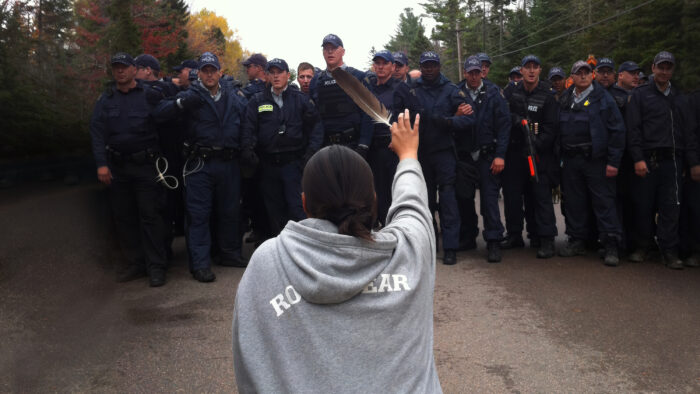
Exploring the concept of identity in the classroom through Indigenous films
Exploring the concept of identity in the classroom through Indigenous films
This post is written by Jane Hubbard, an education consultant who has worked on developing curriculum that explores the subject of the Indian Residential School System in Canada. She has also contributed to the development of a facilitator’s guide and other pedagogical materials for the NFB.
Inuit identity
Indigenous people have a rich tradition of oral history and storytelling that is used to convey knowledge, history, culture, identity, worldview and philosophy of life to successive generations. Examining this narrative approach along with other Indigenous pedagogies, such as collaborative learning and empathy, can lead students to a holistic consideration of Inuit identity while allowing for self-exploration within the same cognitive space.
Inuit people identify strongly with the land on which they live. This close relationship with weather, animals, plants, and terrain was born out of necessity and was essential to survival. The harsh climate of the Inuit homelands demanded that its inhabitants make concerted efforts to obtain food, shelter, and other essentials, although this has shifted as southern culture has collided with traditional practices. So in this way the landscape has become central to the peoples’ survival, inextricably woven into their very beings.
Day-to-day occurrences and notable events are remembered in the oral traditions and have become a part of the Inuit identity. Places, animals, and landmarks take their place in Inuit consciousness and collective identity alongside family, tradition, and community.
Identity: A unique person with a unique story to tell
Timuti and The Wings of Johnny May are films that explore identity in very different ways, but with a focus on common themes. By gaining a deeper knowledge of the influences that shape Inuit identity, students who may be grappling with self-definition can assimilate these concepts to help them discover which factors are impacting their own identity. Have students think about the following questions as they watch the films: What is identity? Is it who I am on the inside or on the outside, or both? Ask them to consider how their own culture—language, food, customs, family, and community—makes them who they are: a unique person with a unique story to tell.
Static vs. dynamic identity
In Timuti, we see the story of a baby boy and how his identity is forged out of a combination of personal, family, traditional, and community experiences. Landscape scenes interspersed with archival and contemporary views of family life deliver a clear message as to which forces collaborate to make Timuti unique. His family speaks about the importance of his name, how it will help him to know where he came from and how it is an integral part of who he is and who he will become. This gives rise to the question of whether identity is static or whether it changes over time and with experience.
The Wings of Johnny May tells the story of Inuk pilot Johnny May against the backdrop of the broader story of the Inuit people and the challenges they face as a result of rapid sociocultural and environmental change. The film addresses the consequences of these changes, their impact on Johnny and his family, and what they are doing to restore balance to their Inuit identity as southern culture encroaches. What are some of the different ways that identity is represented or described in this film?
The Wings of Johnny May (Clip), Marc Fafard, provided by the National Film Board of Canada
Having students share, in small groups, their understanding of what constitutes Inuit identity, as well as their own personal stories of identity, fosters a collaborative environment in the classroom. This cooperative approach imbues the activity with an element of interactivity and engagement, which allows students to gain a more thorough understanding of the subject matter and increases the likelihood of retention. The realization that though Inuit identity may be different than their own, it is shaped by many of the same influences, can lead students to a place of empathetic understanding and to grasp the human connection at its most basic level.
To learn more
The Inuit have a long and vibrant tradition of passing tales and legends down from one generation to the next using visual arts and storytelling. For the past 75 years, the National Film Board of Canada (NFB) has been documenting life in the Arctic through the production of films by, and about, the Inuit. The NFB’s collection of more than 100 documentaries and animated films represents a unique audiovisual account of the life of the Inuit—an account that should be shared with, and celebrated by, all Canadians.
The National Film Board of Canada – in collaboration with the Inuit Relations Secretariat of Aboriginal Affairs and Northern Development Canada, the Government of Nunavut (Department of Education), and with the support of Inuit organizations – has selected more than 60 films from its collection, the most important worldwide, that represent all 4 Canadian Inuit regions (Nunatsiavut, Nunavik, Nunavut and Inuvialuit), some available in Inuktitut.
Discover a powerful portrait of the Inuit experience, past and present, in these animated shorts and documentaries.
Find more great films that capture the spirit of the Arctic, and connect with Inuit culture at nfb.ca/unikkausivut
For more info about this project, click here.






Merci pour ce beau projet. J’aimerais en savoir davantage . Pouvez-vous me contacter
Merci